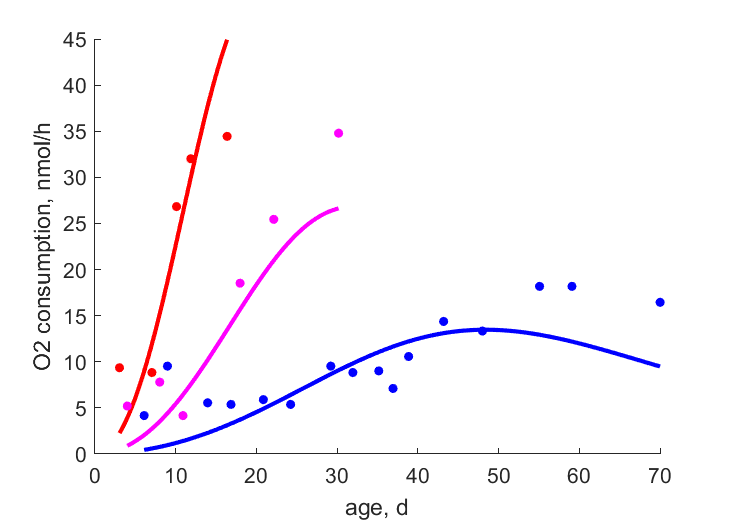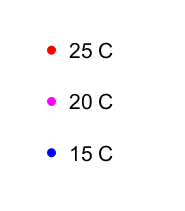Predictions & Data for this entry
| Model: std | climate: Cfb | migrate: Mp | phylum: |
| COMPLETE = 3.0 | ecozone: TA | food: biCi, biHl, biHs | class: |
| MRE = 0.145 | habitat: 0iFr, 0iFm | gender: D | order: |
| SMSE = 0.040 | embryo: Fh | reprod: O | family: |
Zero-variate data
| Data | Observed | Predicted | (RE) | Unit | Description | Reference |
|---|---|---|---|---|---|---|
| ab_15 | 56 | 41.95 | (0.2509) | d | age at birth at 15 C | MuelJoss2011 |
| ab_20 | 29 | 25.12 | (0.1338) | d | age at birth at 20 C | MuelJoss2011 |
| ab_25 | 16 | 15.3 | (0.04362) | d | age at birth at 25 C | MuelJoss2011 |
| ap | 8030 | 7652 | (0.04704) | d | age at puberty for female | BrooKind2002 |
| apm | 6205 | 6657 | (0.07289) | d | age at puberty for male | BrooKind2002 |
| am | 2.92e+04 | 2.92e+04 | (8.94e-05) | d | life span | Wiki |
| L110 | 2.7 | 3.244 | (0.2015) | cm | total length at 110 d | MerrSchm1984 |
| L240 | 6 | 6.141 | (0.02343) | cm | total length at 240 d | MerrSchm1984 |
| Lp | 83.5 | 91.04 | (0.09034) | cm | total length at puberty for female | BrooKind2002 |
| Lpm | 77 | 74.89 | (0.02742) | cm | total length at puberty for male | BrooKind2002 |
| Li | 150 | 116.2 | (0.2254) | cm | ultimate total length | WhitPoll1960 |
| Wdb | 0.00165 | 0.002166 | (0.3128) | g | dry weight at birth | MuelJoss2011 |
| Wwb | 0.00839 | 0.01083 | (0.2909) | g | wet weight at birth | MuelJoss2011 |
| Wwi | 4.3e+04 | 4.303e+04 | (0.0007786) | g | ultimate wet weight | WhitPoll1960 |
| Ri | 1.644 | 1.535 | (0.06631) | #/d | maximum reprod rate | PuseKenn2004 |
Uni- and bivariate data
| Data | Figure | Independent variable | Dependent variable | (RE) | Reference |
|---|---|---|---|---|---|
| aJO_25 |   | age | O2 consumption | (0.2375) | MuelJoss2011 |
| aJO_20 |   | age | O2 consumption | (0.2746) | MuelJoss2011 |
| aJO_15 |   | age | O2 consumption | (0.3059) | MuelJoss2011 |
Pseudo-data at Tref = 20°C
| Data | Generalised animal | Neoceratodus forsteri | Unit | Description |
|---|---|---|---|---|
| v | 0.02 | 0.0173 | cm/d | energy conductance |
| kap | 0.8 | 0.9987 | - | allocation fraction to soma |
| kap_R | 0.95 | 0.95 | - | reproduction efficiency |
| p_M | 18 | 13.04 | J/d.cm^3 | vol-spec som maint |
| k_J | 0.002 | 0.002 | 1/d | maturity maint rate coefficient |
| kap_G | 0.8 | 0.7301 | - | growth efficiency |
Discussion
- Males are assumed to differ from females by {p_Am} only
Facts
- The female has a large ovary and the potential to lay many eggs, but in the wild only produces a few hundreds of eggs, at most, during her lifetime. In captivity, anywhere from 200 to 500-600 eggs have been laid in a single event. The lungfish does not necessarily spawn every year. A good spawning season occurs approximately once every five years, regardless of environmental conditions. (Ref: PuseKenn2004)
- During the first week it lies on its side, hiding in the weeds and moving only when stimulated by touch. It will swim spontaneously, and often retreat back into the gelatinous envelope when disturbed. Newly hatched larvae develop a ciliary current over the skin and gill surfaces. Larvae are reported not to feed for 2-3 weeks while the yolk is still present. (But MuelJoss2011 give 0.0452 g gut-free wet weigth at yolk absorption and 0.00893 at hatch). By the time the yolk is fully utilized, a spiral valve has developed in the intestine and the fish starts to feed. The young can be fast growing, and can grow about 2 inches per month under optimal conditions. (Ref: WhitBone1980)
- The lungfish is tolerant of cold, but prefers waters with temperatures between 15-25 C. Both sexes follow similar growth patterns, although the females grow to a slightly larger size. (Ref: PuseKenn2004)
Bibliography